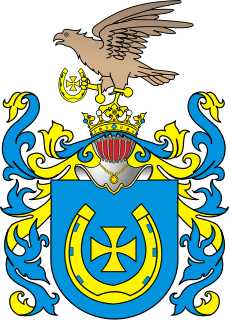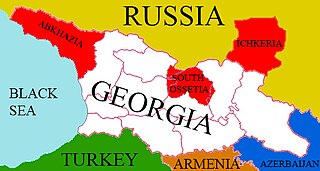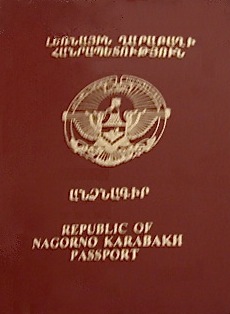Coat of arms of Ossetia may refer to
- Coat of Arms of the Republic of North Ossetia–Alania, a federal subject of Russia
- Coat of arms of South Ossetia, a disputed region in the Caucasus
Coat of arms of Ossetia may refer to

A coat of arms is a heraldic visual design on an escutcheon, surcoat, or tabard. The coat of arms on an escutcheon forms the central element of the full heraldic achievement, which in its whole consists of a shield, supporters, a crest, and a motto. A coat of arms is traditionally unique to an individual person, family, state, organization, school or corporation. The term itself of 'coat of arms' describing in modern times just the heraldic design, originates from the description of the entire medieval chainmail 'surcoat' garment used in combat or preparation for the latter.

The Arms of Canada, also known as the Royal Coat of Arms of Canada or formally as the Arms of Her Majesty The Queen in Right of Canada, is, since 1921, the official coat of arms of the Canadian monarch and thus also of Canada. It is closely modelled after the royal coat of arms of the United Kingdom with French and distinctive Canadian elements replacing or added to those derived from the British version.

Ossetia is an ethnolinguistic region located on both sides of the Greater Caucasus Mountains, largely inhabited by the Ossetians. The Ossetian language is part of the Eastern Iranian branch of the family of Indo-European languages. Most countries recognize the Ossetian-speaking area south of the main Caucasus ridge as lying within the borders of Georgia, but it has come under the control of the de facto government of the Russian-backed Republic of South Ossetia. The northern portion of the region consists of the republic of North Ossetia–Alania within the Russian Federation.

In heraldry, supporters, sometimes referred to as attendants, are figures or objects usually placed on either side of the shield and depicted holding it up.

The royal coat of arms of the United Kingdom, or the royal arms for short, is the arms of dominion of the British monarch, currently Queen Elizabeth II. These arms are used by the Queen in her official capacity as monarch of the United Kingdom. Variants of the royal arms are used by other members of the British royal family, by the British Government in connection with the administration and government of the country, and some courts and legislatures in a number of Commonwealth realms. A Scottish version of the royal arms is used in and for Scotland. The arms in banner form serve as basis for the monarch's official flag, the Royal Standard.

South Ossetia, officially the Republic of South Ossetia–the State of Alania, is a breakaway state in the South Caucasus. It has an officially stated population of just over 53,000 people, who live in an area of 3,900 square kilometres (1,500 sq mi), on the south side of the Greater Caucasus mountain range, with 30,000 living in the capital city, Tskhinvali. The five countries of Russia, Venezuela, Nicaragua, Nauru, and Syria recognise South Ossetia as a sovereign state. While Georgia does not control South Ossetia, the Georgian government and the United Nations consider the territory part of Georgia, whose constitution designates the area as "the former autonomous district of South Ossetia", in reference to the South Ossetian Autonomous Oblast disbanded in 1990.
This armorial of sovereign states shows the coat of arms, national emblem, or seal for every sovereign state. Although some countries do not have an official national emblem, unofficial emblems which are de facto used as national emblems are also shown below.

Jastrzębiec is a Polish coat of arms. It was used by several szlachta families prior to and during the Polish–Lithuanian Commonwealth, and is still used to the present day. During World War II and the communist reform, many families lost their commonwealth status, as well as their right to their manors and sometimes vast lands.

The emblems of the constituent republics of the Union of Soviet Socialist Republics all featured predominantly the hammer and sickle and the red star that symbolised communism, as well as a rising sun, surrounded by a wreath of wheat. The USSR State motto, Workers of the world, unite!, in both the republic's language and Russian was also placed on each one of them. In addition to those repetitive motifs, emblems of many Soviet republics also included features that were characteristic of their local landscapes, economies or cultures.
Papal coats of arms are the personal coat of arms of popes of the Catholic Church. These have been a tradition since the Late Middle Ages, and has displayed his own, initially that of his family, and thus not unique to himself alone, but in some cases composed by him with symbols referring to his past or his aspirations. This personal coat of arms coexists with that of the Holy See.

The Flag of the Republic of North Ossetia–Alania, a federal subject of Russia, is a tricolour, top to bottom white, red, and yellow. The flag is also said to represent the social structure of ancient Ossetian society, which was divided into three social groups forming an organic whole: the military aristocracy, the clergy, and ordinary people. The colours symbolise moral purity (white), martial courage (red) and wealth and prosperity (yellow). In blazons, the flag is described as Per fess Argent and Or, a fess Gules. The proportions are 1:2.

The Coat of arms of the Republic of North Ossetia-Alania, a federal subject of Russia, is a red disc featuring a Caucasian leopard with seven white mountains in the background. The mountains symbolize the Ossetian landscape, while the leopard is an iconic inhabitant of the Caucasus mountains.

The 1991–1992 South Ossetia War was fought between Georgian government forces and ethnic Georgian militia on one side and the forces of South Ossetia and North Ossetian volunteers who wanted South Ossetia to secede from Georgia and become an independent state on the other. The war ended with a Russian-brokered ceasefire, signed on 24 June 1992, which established a joint peacekeeping force and left South Ossetia divided between the rival authorities.

The Provisional Administration of South Ossetia is an administrative body that Georgia regards as the legal government of South Ossetia. The administration was set up by the Georgian government as a transitional measure leading to the settlement of South Ossetia's status. As of 2007, Georgia is proposing the status of autonomous republic within the Georgian state. The area mainly lies within the Shida Kartli region.

The coats of arms of the Holy See and Vatican City in the form that combines two crossed keys and a tiara used as a coat of arms of the Holy See have origins attested from the 14th century. The combination of one gold and one silver key is a somewhat later development.

South Ossetia is a region in the North Caucasus that is under the effective control of the self-declared Republic of South Ossetia–the State of Alania but recognized by most of the international community as part of Georgia. The Government of Georgia has established a Provisional Administration of South Ossetia which it considers to be the legal government of South Ossetia. Both entities have adopted a similar flag to represent themselves, a tricolour, top to bottom white, red, and yellow.
South Ossetia is a region in the North Caucasus that is under the effective control of the self-declared Republic of South Ossetia–the State of Alania but recognized by most of the international community as part of Georgia. The Government of Georgia has established a Provisional Administration of South Ossetia which it considers to be the legal government of South Ossetia.

Artsakh Passports are issued to Artsakh citizens to travel outside the partially recognized Republic of Artsakh. They are also used as proof of identity within the country. Passports of the Republic of Artsakh are issued based on amendments to the Constitution of Artsakh of 2006.
The Lion King is a 1994 animated Disney film.